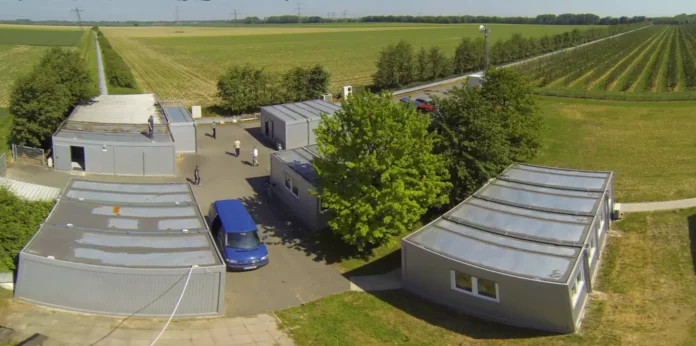Gravitational waves come in all shapes and sizes – and frequencies. But, so far, we haven’t been able to capture any of the higher frequency ones. That’s unfortunate, as they might hold the key to unlocking our understanding of some really interesting physical phenomena, such as Boson clouds and tiny block hole mergers. A new paper from researchers at Notre Dame and Caltech, led by PhD student Christopher Jungkind, explores how we might use one of the world’s most prolific gravitational wave observatories, GEO600, to capture signals from those phenomena for the first time.
GEO600 is a gravitational wave observatory based in Germany, and has been in operation for more than 20 years. However, we recently reported on an update to the laser and data collection system that upgraded the observatory’s capabilities, and which the operators will be taking through its paces over the rest of this year. But there’s another aspect of GEO600 that Mr. Jungkind and his co-authors think could improve its sensitivity, especially at higher frequencies – its mirrors.
One of the primary features of GEO600 is its signal-recycling mirror (MSR), which, under normal operation, creates a signal-recycling cavity that amplifies the gravitational wave (GW) signal. Typically, it is set to amplify GWs with frequencies between 10s to 1000s of Hz. However, according to the paper, a slight modification can make the entire system much more sensitive at higher frequencies.
Video describing the GEO600 gravitational wave detector. Credit – Max Planck Institute for Gravitational Physics YouTube Channel
That modification is changing the angle of the MSR – more commonly referred to as the “detuning” angle. As the angle changes, the frequency the cavity amplifies changes as well. So, at least in theory, GEO600’s operators could sweep across a wide range of higher frequency amplifications simply by making small adjustments to the detuning angle.
To prove their point, the authors turned to every theoretical physicist’s favorite tool – a simulator. In this case, that is the Finesse 3.0 software package, whereby added sources of noise, such seismic noise from the Earth and quantum noise from radiation pressure, while still considering the upgraded laser capabilities of the GEO600. They found a significant increase in the detector’s sensitivity that moves along with the increasing detuning angle.
In particular, GEO600 would become more sensitive than advanced LIGO (aLIGO) , a competing ground-based GW detector that is an upgrade from the LIGO observatory that first detected GWs back in 2016. GEO600 would be more capable of detecting GWs with a frequency above 6K Hz, according to the study.
Even 9 years ago, GEO600 scientists were talking about advanced LIGO. Credit – Max Planck Institute for Gravitational Physics
But what does that mean in practice? Simulations showed that it would be better at detecting gravitational waves from a specific kind of Boson cloud, known as a vector boson cloud. Unfortunately, another type of Boson cloud, known as a scalar boson cloud would be much harder to detect. Despite both being named after concepts from calculus, the two types of boson clouds are composed of different hypothetical fundamental particles, which cause different types of GWs when surrounding a black hole. The frequency that the black holes at the center of these boson clouds emit GWs is directly proportional to the mass of the bosons that make up the clouds. GWs created by vector boson clouds vibrate at a frequency up to 31.5kHz, which is at least theoretically in the detectable range for the improved GEO600 with detuning. However, scalar boson clouds produce much weaker signals, even if they are much longer lasting, making it unlikely that GEO600 would be able to detect them.
The other physical phenomena that would be of interest would be the merger of sub-stellar mass black holes. While GEO600 using detuning could detect these, according to the simulations there wouldn’t be much, if any, of an advantage over other detectors like aLIGO, as most of the signal comes in lower frequencies while the two black holes are spiraling into each other.
So, at least for some physical phenomena, a slight tweak to the mirror controls of GEO600 could provide dramatically improved insight into the features of some types of boson clouds. However, updating that control scheme can be difficult, as it requires a feedback loop between the sensor itself and the actuator driving the mirror angle. That’s something the engineers would have to work on, if GEO600’s operators decide to do so. For now, at least, simulations are the best we’ll be able to get in terms of improving high-frequency GW detection.
Learn More:
C. Jungkind et al – Prospects for High-Frequency Gravitational-Wave Detection with GEO600
UT – The GEO600 Gravitational Wave Detector is Getting a Big Upgrade
UT – Astronomers Detected a Black Hole Merger With Very Different Mass Objects
UT – Gravitational Waves Could Give Us Insights into Fast Radio Bursts


